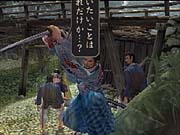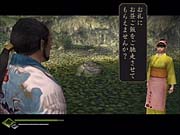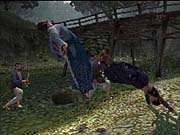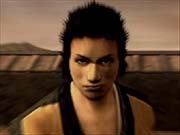Way of the Samurai Preview
We take a look at the Japanese version of Acquire's Way of the Samurai. See what the studio that created Tenchu has been up to for the past few years.

Fans of the Tenchu series don't know what to think these days. The next game in the popular ninja series, Tenchu III, is due out later this year for the PlayStation 2, but a new developer is working on it. Meanwhile, Acquire, the developer responsible for originally creating the Tenchu series, recently released Way of the Samurai for the PS2 in Japan. Since one of the best elements of the Tenchu series was sneaking around as a ninja, some are concerned that Way of the Samurai is simply "Tenchu without stealth." We recently played the Japanese version of the game to get a sense of whether or not that's actually the case.
The game is set in a period in Japanese history when the role of the samurai has begun to fade. You play as a ronin who has wandered into the middle of a feud between two clans over a nearby iron foundry. Decisions you make during the game will affect how specific events in the game play out. For instance, in one case, you'll cross a bridge when a warrior kidnaps a local girl. You can either choose to confront him and try to stop him or opt to leave the fight for one of her friends. Or you can avoid the bridge altogether and take a different path. Perhaps more notably, if you surrender during a fight with a specific warrior, he'll tie you to a section of train tracks. After he wanders off, you can try to make enough noise to attract other samurai. You might be able to talk them into freeing you, but, in our case, they just left us on the tracks. Branching paths like this one are littered throughout the game.

When you approach characters in the game, you can choose to speak to them, ignore them, or draw your sword and attack. (Wandering around with your sword drawn is a good way to invite trouble, if that's what you're looking for.) Occasionally, events draw you in without your having chosen them, and you can decide then whether or not to participate. As we mentioned before, though, attempting to bow out gracefully can produce adverse results. Besides offering branching paths and multiple outcomes, the game lets you unlock different samurai and robes from the character customization screen, as well as extra features like the two-player versus mode, which adds to the game's replay value.
As in Square's Bushido Blade, the game environments are expansive and seamless--new areas are loaded once you reach another's borders. You can find health-recharging items, such as vegetables and mushrooms, scattered throughout the land on farms, in gardens, and on paths. You can also sometimes run away from a fight to find one of these to eat, but since the time it takes to sheath or draw your sword leaves you very open to attack, you have to do this very carefully. You also have to be careful of what you eat, since some items can damage you, rather than replenish your health.

Way of the Samurai is a tough game right from the start, and players will become accustomed to seeing the introductory screen multiple times as they hone their skills. Those who remember Tenchu II's gruelingly difficult boss fights will have a sense of how important it is to master the attack and block moves, as well as ignore the impulse to simply slash madly. Skill is even more important in Way of the Samurai, since there aren't any special items like bombs or magic spells to aid you.
The game's controls are easy to learn but difficult to master. The square and triangle buttons are your quick and powerful sword attacks, while the R1 button blocks and X lets you jump. Combining your sword attacks with directional moves will generate special attacks, and attacking while blocking or when knocked on the ground will generate a kick, which can momentarily knock your opponent off balance. Moving forward or back while blocking, conversely, shifts your weight and can also produce the same results; this is a very important skill to cultivate.

You can also become more effective in battle by gaining better swords. You can do this by upgrading your blade's abilities at a local blacksmith or by taking valuable weapons from fallen boss enemies. You can improve your katana in terms of offensive and defensive abilities and acquire health bonuses for your character. You can carry up to three swords at a time, so it's possible to choose the most appropriate weapon for a fight. A sword's durability is represented by a series of blocks on the bottom of the screen. Using your blade during a fight will turn the bar red. If it gets to a certain point, the sword loses a block and the overall durability of the blade drops. If all the blocks on the bar drop, the sword breaks. Staying out of battle for a while will reduce stress on the blade, but you must seek a blacksmith to repair hits to the blade's durability entirely.
Judging from what we've seen, the game's graphics are its main weakness. It looks like a game that developers initially planned for the PlayStation One and then brought to the PlayStation 2 midproject. As should be expected, the color palette is much broader, and the character models are much more advanced than those in Tenchu II, but it looks pretty lackluster in comparison with most current PS2 games. More importantly, characters occasionally pop in and out of existence, the collision detection can be problematic at times, and the fact that you're robbed of camera control during combat is quite frustrating.
Acquire is known for making improvements upon games in the time between their Japanese and US release, so there remains hope that the pop-up and collision detection problems are cleared up between now and the game's planned summer release. At the very least, the game's branching paths and customizable options ensure that Way of the Samurai won't be living in the shadow of the Tenchu series when it hits US shores.
Got a news tip or want to contact us directly? Email news@gamespot.com
Join the conversation